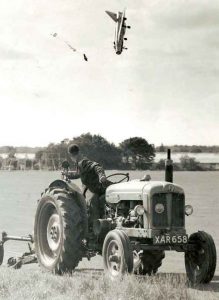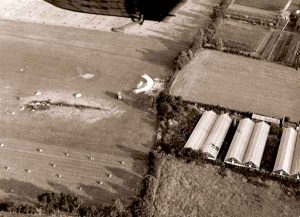 Sometimes we see a picture that looks so far-fetched that we assume that we are looking at a picture that has been photoshopped, and sometimes we are. Nevertheless, some pictures, unbelievable as they may seem, are the real deal. A while back, I stumbled upon an unbelievable photo of a plane crash, or rather the moment before the plane crashed. I was instantly intrigued. Could this be real? Or was it just a big ruse?
Sometimes we see a picture that looks so far-fetched that we assume that we are looking at a picture that has been photoshopped, and sometimes we are. Nevertheless, some pictures, unbelievable as they may seem, are the real deal. A while back, I stumbled upon an unbelievable photo of a plane crash, or rather the moment before the plane crashed. I was instantly intrigued. Could this be real? Or was it just a big ruse?
At the end of World War II, the English Electric Aviation Company received a contract to develop a jet bomber. The resulting bomber was the English Electric Lightning F1. The ER103 design study was sufficiently impressive for English Electric to be awarded the contract for two prototypes and a structural-test airframe. The early prototypes evolved into the Lightning, an airplane which was to span the time from when the Spitfire was our primary front-line fighter to the end of the Cold War. The Lightning was the only British designed and built fighter capable of speeds in excess of Mach 2 to serve with the Royal Air Force. The aircraft in the photograph was XG332. It was built in 1959, one of 20 pre-production Lightnings. Alan Sinfield took a photograph of XG332 in 1960 at Farnborough. However, it was the very last photograph taken of XG332, in 1962, that became the famous one, and deservedly so. How does someone manage to take a photograph like this? Jim Meads is the man who took the picture, but this was not the picture he expected to take that day. He was a professional photographer who lived near the airfield. In fact, he lived next door to de Havilland test pilot Bob Sowray.
Meads says that Bob Sowray mentioned that he was going to fly the Lightning that day. An excited Meads took his kids for a walk, taking his camera along, hoping to get a shot of the plane, and give his kids something amazing to remember. Well, that part of the walk went according to plan. It was a walk his kids would not soon forget. He had planned to take a photograph of the children with the airfield in the background, just as the Lightning came in to land. They found a good view of the final approach path and waited for the Lightning to return. As it turned out, Bob Sowray didn’t fly the Lightning that day. The pilot was George Aird, another test pilot working for De Havilland. George Aird was involved in the Red Top Air-to-Air Missile program. He was a well-respected test pilot.
The flight was to take place on September 19, 1962. The day did not go as planned in any way. George Aird was in the Lightning doing a demonstration flight off of the south coast. As he approached Hatfield from the north east, he realized that he had trouble. During the flight there was a fire in the aircraft’s reheat zone. “Un-burnt fuel in the rear fuselage had been ignited by a small crack in the jet pipe and had weakened the tailplane actuator anchorage. This weakened the tailplane control system which failed with the aircraft at 100 feet on final approach.” The plane suddenly pitched up, quite violently…just as Aird was coming in to land. Aird lost control of the aircraft and ejected. Had the nose of the plane not pitched up suddenly, Aird would not have had enough time to eject.
The tractor in the photograph was a Fordson Super Major. Upon close inspection of the grill, one can see that it reads D H Goblin, which is the name of another de Havilland jet engine…the Goblin. The tractor driver was 15-year-old Mick Sutterby, who spent that summer working on the airfield. He would play an amazing, but unexpected part in the amazing picture. He wasn’t posing for the camera, but rather, was telling the photographer, Jim Mead, to move on, because he shouldn’t be there. Mead saw the plane coming in and the nose pitch up. Then Aird ejected and Mead says he had just enough time to line up the shot as the Lightning came down nose first.
Sutterby recalls, “I followed my father into work at de Havilland, Hatfield in 1954 when I was 15. My father was the foreman in charge of the aerodrome and gardens. My job in the summer was gang-mowing the airfield and at the time of the crash in 1962 the grass had stopped growing and we were trimming round the ‘overshoot’ of the runway with a ‘side-mower’. I stopped to talk to a chap with a camera who was walking up a ditch to the overshoot. I stopped to tell him that he shouldn’t be here, I heard a roar and turned round and he took the picture! He turned out to be a friend of the pilot and had walked up the ditch to photograph his friend in the Lightning. I saw some bits fly off the plane before it crashed, but it was the photographer who told me he had ejected. There was not a big explosion when it crashed, just a loud ‘whhooooof’.”
“I was about 200 yards from the crash scene. I saw men running out of the greenhouses and checking the scene of the crash. The works fire brigade were on the scene within a minute. Somewhere at home I have a picture of it burning. Although the picture shows it nose diving to the ground, in fact it was slowly turning over and it hit the ground upside down nose first. I was later told that if the pilot had ejected a split second later he would have ejected himself into the ground. I was very lucky. If I had known he was coming into land, I would have been positioned near the ILS (Instrument Landing System) aerial which was only 20 yards or so from the crash site! I believe the photographer had his photo restricted by the Air Ministry for – I think – about 3 months because the plane was secret,” Sutterby said, almost as if in thought.
“He then took it to the Daily Mail who said it was a fake. The photo was eventually published by the Daily  Mirror. From there it went round the world, and I remember seeing a copy in the RAF museum at Hendon. I recollect the photographer usually photographed hunting scenes for magazines like The Field. I recollect that the pilot broke his legs but really was very lucky. I hope this is interesting. All from memory,” finished Sutterby.
Mirror. From there it went round the world, and I remember seeing a copy in the RAF museum at Hendon. I recollect the photographer usually photographed hunting scenes for magazines like The Field. I recollect that the pilot broke his legs but really was very lucky. I hope this is interesting. All from memory,” finished Sutterby.
George Aird didn’t have an easy landing, and in fact, landed on a greenhouse and fell through the roof. The fall broke both of his legs, and he landed on the ground, unconscious. The water from the sprinkler system for the tomatoes woke him up and he reportedly said that his first thought was that he must be in heaven. In the end no one was killed, but the resulting picture by Jim Meads is nothing short of spectacular!!


2 Responses to Nothing Short Of Spectacular